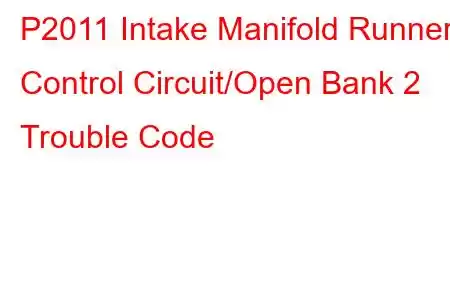P2011 Intake Manifold Runner Circuit Open Bank 2
OBD-II Trouble Code Technical Description
Intake Manifold Runner Control Circuit Open Bank 2
What does that mean?
The OBD trouble code P2011 is a generic powertrain code, which means that it applies to all 1996-newer vehicles (Ford, VW, Audi, GM, etc.). Although generic, the engines differ between brands and may have slightly different causes for this code.
Always refer to a vehicle specific service manual for the proper diagnostic sequence and reference numbers.
The code is referring to a fault that has occurred in a set of air control flaps inside the intake manifold. These flaps are designed to create a specified amount of turbulence within the manifold that is transformed into a 'swirling' effect.
By creating a swirling of the intake air, the pulsations created by the intake valve opening and closing is nullified and the quality of the air fuel mixture is improved. Low end torque is improved and the formation of Nox is reduced as well with the use of these flaps.
The electronic control module (ECM) controls the position of the swirl flaps with the use of an intake manifold runner control solenoid valve after referencing the signals from the mass air flow sensor (MAF) and the barometric pressure sensor. When the ECM determines where to position the swirl flaps, it uses 'pulse width modulation' to control the intake runner control solenoid.
There are several possible reasons for this fault to occur, however, the swirl flaps themselves cause the most concern. The reason is that they are inside the intake manifold. Should they be the problem and fail, parts will fall and be ingested into the engine. That is a recipe for a bad day.
Once it's been determined that they are not the problem, the stress level drops. Certain vehicles were notorious for swirl flap failure where the screws retaining the flaps would fall out if the flap failed. The screws entered the engines and caused major engine damage. This engine code is identical to P2008 but that code is for Bank 1, and this DTC is for Bank 2. Bank #2 is the side of the engine that does not contain cylinder #1.
Symptoms
Symptoms of a P2011 DTC may include:
The engine may have a rougher than normal idle At times the engine may exhibit a tendency to surge There may be a slight reduction in low-end torque The trouble code P2011 will be displayedThis is a 'soft' code, meaning the check engine light may blink on and off only when the ECM sees the fault. If the fault corrects itself the light will go off. Hard codes will remain once observed until erased.
Potential Causes
The causes for this DTC may include:
Over the years I have found that the intake runner control solenoid is largely the problem. They are almost always situated where they are subjected to heat and dirt that fouls the filter causing them to fail. Secondly, the swirl flaps themselves become covered with soot from the EGR valve, and they lock in their current position. The MAF sensor or the EGR have the ability to set this code if they fail, however, they will set a code of their own to coincide with the P2011 code. In this case they would be diagnosed and repaired first and the codes erased The intake manifold runner control solenoid The swirl flaps are contaminated Broken vacuum lines Poor electrical connection Open or short in the wiring harnessDiagnosis & Repair
A service manual for the vehicle and a scan tool will be necessary to diagnose and effect a conclusive repair. The ECM uses pulse width modulation to vary the position of the swirl flaps with the intake runner solenoid.
Check the vacuum hoses and make sure there are no cracks and that they are in place. Inspect the electrical connector on the solenoid. Look for corrosion or a loose fitting connection. Disconnect the connector on the solenoid and plug the scan tool into the solenoid connector. Go to the VSV operational check. Turn the key on. Operate the solenoid with the scanner by making it open and close. If it fails to respond replace the valve. If the valve functions but has difficulty in moving the actuating rod, replace the intake manifold. If the solenoid fails to function, disconnect the electrical connector. Look in the main fuse block and pull the EFI relay. Using a Ohmmeter, check the continuity between the EFI terminals and the solenoid terminals on the harness side. Reference the service manual and locate the ground terminal on the solenoid's harness connector and test it for ground.Read: 20


